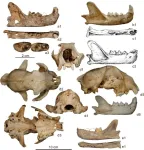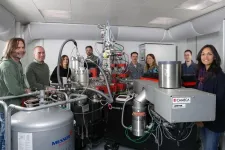(Press-News.org) Most treatments being pursued today to protect against Alzheimer’s disease focus on amyloid plaques and tau tangles that accumulate in the brain, but new research from Mass General Brigham and Washington University School of Medicine in St. Louis points to a novel—and noble—approach: using Xenon gas. The study found that Xenon gas inhalation suppressed neuroinflammation, reduced brain atrophy, and increased protective neuronal states in mouse models of Alzheimer’s disease. Results are published in Science Translational Medicine, and a phase 1 clinical trial of the treatment in healthy volunteers will begin in early 2025.
“It is a very novel discovery showing that simply inhaling an inert gas can have such a profound neuroprotective effect,” said senior and co-corresponding author Oleg Butovsky, PhD, of the Ann Romney Center for Neurologic Diseases at Brigham and Women’s Hospital (BWH), a founding member of the Mass General Brigham healthcare system. “One of the main limitations in the field of Alzheimer’s disease research and treatment is that it is extremely difficult to design medications that can pass the blood-brain barrier—but Xenon gas does. We look forward to seeing this novel approach tested in humans.”
“It is exciting that in both animal models that model different aspects of Alzheimer’s disease, amyloid pathology in one model and tau pathology in another model, that Xenon had protective effects in both situations,” said senior and co-corresponding author David M. Holtzman, MD, from Washington University School of Medicine in St. Louis.
The causes of Alzheimer’s disease are not fully understood; there is currently no cure, and more effective treatments are desperately needed. Characterized by protein buildups in the brain, including tau and amyloid, Alzheimer’s disease disrupts nerve cell communication and causes progressive brain abnormalities that lead to neuronal damage and ultimately to death. Microglia, the brain’s primary and most prominent immune cells, act as ‘first responders’ when something goes awry in the brain, and they play a key role in regulating brain function in all phases of development. Microglial dysregulation is a key component of Alzheimer’s disease. Butovsky’s lab previously designed a way to study how microglia respond to neurodegeneration and confirmed that a specific phenotype of microglia can be modulated in a way that is protective in Alzheimer's disease.
In this study, mouse models of Alzheimer’s disease were treated with Xenon gas that has been used in human medicine as an anesthetic and as a neuroprotectant for treating brain injuries. Xenon gas penetrates the blood-brain barrier, passing from the bloodstream directly into the fluid surrounding the brain. The team found that Xenon gas inhalation reduced brain atrophy and neuroinflammation and improved nest-building behaviors in the Alzheimer’s disease mouse models. It also induced and increased a protective microglial response that is associated with clearing amyloid and improving cognition. Together, these findings identify the promising potential of Xenon inhalation as a therapeutic approach that could modify microglial activity and reduce neurodegeneration in Alzheimer’s disease.
The clinical trial at Brigham and Women’s Hospital, which will initially only enroll healthy volunteers, is set to begin in the next few months.
As early phases of the clinical trial get underway to establish safety and dosage, the research team plans to continue to study the mechanisms by which Xenon gas achieves its effects in addition to its potential for treating other diseases such as multiple sclerosis, amyotrophic lateral sclerosis, and eye diseases that involve the loss of neurons. The team is also devising technologies to help use Xenon gas more efficiently as well as potentially recycle it.
“If the clinical trial goes well, the opportunities for the use of Xenon gas are great,” said co-author Howard Weiner, MD, co-director of the Ann Romney Center for Neurologic Diseases at BWH and principal investigator of the upcoming clinical trial. “It could open the door to new treatments for helping patients with neurologic diseases.”
Authorship: In addition to Butovsky and Weiner, Mass General Brigham authors include Wesley Brandao, Zhuoran Yin, Kilian L. Kleemann, Madison Carpenter, Ana Durao, Jen-Li Barry, Caroline Baufeld, Dilansu Guneykaya, Xiaoming Zhang, Neta Rosenzweig, Kristen M. Pitts, Michael Aronchik, Taha Yahya, Tian Cao, Marcelo Kenzo Takahashi, Rajesh Krishnan, Additional authors include Nimansha Jain, Xin Bao, Javier R. Serrano, Eric Tycksen, Alexandra Litvinchuk, Hong Jiang, Hayk Davtyan, Jason D. Ulrich, Mathew Blurton-Jones, Ilya Ilin, and David M. Holtzman.
Disclosures: Butovsky, Ilin, Weiner, Yin, and Brandao are co-inventors on patent no. 17/914,061 (held by Brigham and Women’s Hospital and General Biophysics) for using Xe to treat neurodegenerative diseases. Butovsky is co-founder and is on the scientific advisory board of Glial Therapeutics and GliaX; collaborates with GSK and Regulus Therapeutics; has research funding from Sanofi, GSK; and consults for/has received honoraria from UCB, Camp4, Ono Pharma USA, General Biophysics. Holtzman co-founded and is on the scientific advisory board of C2N Diagnostics. Holtzman is on the scientific advisory board of Denali, Genentech, and Cajal Neurosciences and consults for Asteroid Therapeutics. Blurton-Jones co-founded and is on the scientific advisory board of NovoGlia Inc. Ilin is the founder and CEO of General Biophysics LLC.
Funding: This study was funded by National Institutes of Health (NIH) (STTR R41AG073059, R01 AG051812 R01 AG054672, R01 NS088137 R01 AG075509, RF1 NS090934, P30 AG066519, U19 AG06970101); Cure Alzheimer Fund; Massachusetts Center for Alzheimer Therapeutic Science (MassCATS); BrightFocus Foundation 2020A016806; Alzheimer’s Association research fellowship AARF-21-846786; National Multiple
Sclerosis Society FG-2108-38372; Department of Defense W81XWH-22-1-0945
Paper cited: Brandao W, et al. “Inhaled Xenon modulates microglia and ameliorates disease in mouse models of amyloidosis and tauopathy.” Science Translational Medicine, DOI: 10.1126/scitranslmed.adk3690
###
About Mass General Brigham
Mass General Brigham is an integrated academic health care system, uniting great minds to solve the hardest problems in medicine for our communities and the world. Mass General Brigham connects a full continuum of care across a system of academic medical centers, community and specialty hospitals, a health insurance plan, physician networks, community health centers, home care, and long-term care services. Mass General Brigham is a nonprofit organization committed to patient care, research, teaching, and service to the community. In addition, Mass General Brigham is one of the nation’s leading biomedical research organizations with several Harvard Medical School teaching hospitals. For more information, please visit massgeneralbrigham.org.
END
Study finding Xenon gas could protect against Alzheimer’s disease leads to start of clinical trial
New research from Mass General Brigham and Washington University School of Medicine in St. Louis found Xenon gas inhalation reduced neurodegeneration and boosted protection in preclinical models of Alzheimer’s disease
2025-01-15
ELSE PRESS RELEASES FROM THIS DATE:
Protein protects biological nitrogen fixation from oxidative stress
2025-01-15
A small helper for big tasks: an oxygen sensor protein protects the enzymatic machinery of biological nitrogen fixation from serious damage. Its use in biotechnology could help to reduce the use of synthetic fertiliser in agriculture in the future. A research team led by biochemist Prof. Dr Oliver Einsle from the Faculty of Chemistry and Pharmacy and the Centre for Biological Signalling Studies (BIOSS) at the University of Freiburg has discovered exactly how the so-called Shethna protein II works. The scientists used the newly established cryo-electron microscopy in Freiburg. ...
Three-quarters of medical facilities in Mariupol sustained damage during Russia’s siege of 2022
2025-01-15
Three-quarters of medical facilities in Mariupol sustained damage during Russia’s siege of 2022, with some evidence that the attacks may have been intentionally targeted, per study using satellite imagery.
####
Article URL: https://journals.plos.org/globalpublichealth/article?id=10.1371/journal.pgph.0003950
Article Title: The effect of conflict on damage to medical facilities in Mariupol, Ukraine: a quasi-experimental study
Author Countries: Germany, United States
Funding: This work was supported ...
Snow leopard fossils clarify evolutionary history of species
2025-01-15
The snow leopard (Panthera uncia) is a large feline unique to the Qinghai-Tibet Plateau and its surrounding areas. As the apex predator in the region, the snow leopard plays a crucial role in maintaining ecological stability. Its unique characteristics, coupled with its striking appearance, have made it a flagship species for conservation efforts aimed at protecting the ecosystem of the Qinghai-Tibet Plateau.
Unfortunately, few snow leopard fossils have been found in the Qinghai-Tibet Plateau region, particularly fossils from the Quaternary period. As a result, it’s unclear how snow leopards evolved their specialized adaptations to this environment.
On the one hand, molecular ...
Machine learning outperforms traditional statistical methods in addressing missing data in electronic health records
2025-01-15
Researchers from the National Institute of Health Data Science at Peking University and the Department of Clinical Epidemiology and Biostatistics at Peking University People's Hospital have conducted a comprehensive systematic review evaluating strategies for addressing missing data in electronic health records (EHRs). Published in Health Data Science, the study highlights the growing importance of machine learning methods over traditional statistical approaches in managing missing data scenarios effectively.
Electronic health records have become a cornerstone in modern healthcare research, enabling analysis across clinical trials, treatment effectiveness studies, and ...
AI–guided lung ultrasound by nonexperts
2025-01-15
About The Study: In this multicenter validation study, trained health care professionals with artificial intelligence (AI) assistance achieved lung ultrasound images meeting diagnostic standards compared with lung ultrasound experts without AI. This technology could extend access to lung ultrasound to underserved areas lacking expert personnel.
Corresponding Author: To contact the corresponding author, Cristiana Baloescu, MD, MPH, email cristiana.baloescu@yale.edu.
To access the embargoed ...
Prevalence of and inequities in poor mental health across 3 US surveys
2025-01-15
About The Study: This survey study documents increasingly prevalent poor mental health from 2011 to 2022 across multiple U.S. health surveys, with notable prevalence differences in Behavioral Risk Factor Surveillance System and National Survey on Drug Use and Health vs National Health Interview Survey. Inequities in these outcomes by age, sex, and racial and ethnic group were often sizeable and changed over time in distinct ways, consistent with findings in prior literature.
Corresponding Author: To contact the corresponding ...
Association between surgeon stress and major surgical complications
2025-01-15
About The Study: In this cohort study including 38 attending surgeons and 793 patients, increased surgeon stress at the beginning of a procedure was associated with improved clinical patient outcomes. The results are illustrative of the complex relationship between physiological stress and performance, identify a novel association between measurable surgeon human factors and patient outcomes, and may highlight opportunities to improve patient care.
Corresponding Author: To contact the corresponding author, Jake Awtry, MD, email jawtry@bwh.harvard.edu.
To access the embargoed study: Visit our For The Media ...
How cryogenic microscopy could help strengthen food security
2025-01-15
According to the United Nations, soil salinization affects between 20% and 40% of arable land globally, with human activity and climate change – especially rising sea levels – largely responsible for this process. While the human body needs sodium to function, this is not the case for most plants. In fact, excess salt around plants’ roots gradually blocks their access to water, stunting their growth, poisoning them and hastening their death. Ten million hectares of farmland are destroyed by soil salinization every year, posing a threat to global food security.
Scientists at EPFL, ...
DNA damage can last unrepaired for years, changing our view of mutations
2025-01-15
While most known types of DNA damage are fixed by our cells’ in-house DNA repair mechanisms, some forms of DNA damage evade repair and can persist for many years, new research shows. This means that the damage has multiple chances to generate harmful mutations, which can lead to cancer.
Scientists from the Wellcome Sanger Institute and their collaborators analysed family trees of hundreds of single cells from several individuals. The team pieced together these family trees from patterns of shared mutations between the cells, indicating common ancestors.
Researchers uncovered unexpected ...
Could this fundamental discovery revolutionise fertiliser use in farming?
2025-01-15
Researchers have discovered a biological mechanism that makes plant roots more welcoming to beneficial soil microbes.
This discovery by John Innes Centre researchers paves the way for more environmentally friendly farming practices, potentially allowing farmers to use less fertiliser.
Production of most major crops relies on nitrate and phosphate fertilisers, but excessive fertiliser use harms the environment.
If we could use mutually beneficial relationships between plant roots and soil microbes to enhance nutrient uptake, ...
LAST 30 PRESS RELEASES:
NTP-enhanced lattice oxygen activation in Ce-Co catalysts for low-temperature soot combustion
Synergistic interface engineering in Cu-Zn-Ce catalysts for efficient CO2 hydrogenation to methanol
COVID-19 leaves a lasting mark on the human brain
Scientists use ultrasound to soften and treat cancer tumors without damaging healthy tissue
Community swimming program for Black youth boosts skills, sense of belonging, study finds
Specific depressive symptoms in midlife linked to increased dementia risk
An ‘illuminating’ design sheds light on cholesterol
Who is more likely to get long COVID?
Study showcases resilience and rapid growth of “living rocks”
Naval Research Lab diver earns Office of Naval Research 2025 Sailor of the Year
New Mayo-led study establishes practical definition for rapidly progressive dementia
Fossil fuel industry’s “climate false solutions” reinforce its power and aggravate environmental injustice
Researchers reveal bias in a widely used measure of algorithm performance
Alcohol causes cancer. A study from IOCB Prague confirms damage to DNA and shows how cells defend against it
Hidden viruses in wastewater treatment may shape public health risks, study finds
Unlock the power of nature: how biomass can transform climate mitigation
Biochar reshapes hidden soil microbes that capture carbon dioxide in farmland
Reducing saturated fat intake shows mortality benefit, but only in high-risk individuals
Manta rays create mobile ecosystems, study finds
Study: Mixed results in using lipoic acid to treat progressive multiple sclerosis
Norbert Holtkamp appointed director of Fermi National Accelerator Laboratory
New agentic AI platform accelerates advanced optics design
Biologists discover neurons use physical signals — not electricity — to stabilize communication
Researchers discover that a hormone can access the brain by hitchhiking
University of Oklahoma researcher awarded funding to pursue AI-powered material design
Exploring how the visual system recovers following injury
Support for parents with infants at pediatric check-ups leads to better reading and math skills in elementary school
Kids’ behavioral health is a growing share of family health costs
Day & night: Cancer disrupts the brain’s natural rhythm
COVID-19 vaccination significantly reduces risk to pregnant women and baby
[Press-News.org] Study finding Xenon gas could protect against Alzheimer’s disease leads to start of clinical trialNew research from Mass General Brigham and Washington University School of Medicine in St. Louis found Xenon gas inhalation reduced neurodegeneration and boosted protection in preclinical models of Alzheimer’s disease



